Difference between revisions of "MessengerCTI Manual"
(Created page with "= Introduction = Slican '''MessengerCTI.Desktop''' is software which purpose is to assist users of Slican PBX. Thanks to the graphic interface displayed on the computer screen...") |
(→NCP PBX) |
||
| (118 intermediate revisions by the same user not shown) | |||
| Line 1: | Line 1: | ||
= Introduction = | = Introduction = | ||
| − | Slican '''MessengerCTI.Desktop''' is software which purpose is to assist users of Slican PBX. Thanks to the graphic interface displayed on the computer screen, software allows for convenient access of telephone calls and other functions related to it. Software delivers additional features that allows to expand capabilities of desk phone. Software combines capabilities of controlling desk phone connected to PBX, for example choosing number, receiving calls and also application is able to function as standalone phone. Software also allows to: accessing PBX's phonebook, call history, status of phone and other users of MessengerCTI, text communication and sending or receiving SMS messages. | + | Slican '''MessengerCTI.Desktop''' is software which purpose is to assist users of Slican PBX. Thanks to the graphic interface displayed on the computer screen, software allows for convenient access of telephone calls and other functions related to it. Software delivers additional features that allows to expand capabilities of desk phone. Software combines capabilities of controlling desk phone connected to PBX, for example choosing number, receiving calls and also application is able to function as standalone phone. Software also allows to: accessing PBX's phonebook, call history, status of phone and other users of MessengerCTI, text communication and sending or receiving SMS messages. Additionally for new version of DPH.IP doorphone equipped with camera - video preview was added. |
| − | Application works with all | + | Application works with all types of phones connected to Slican PBX: CTS system phones, analogue or VoIP phones. In the most recent firmware version of PBX(6.53 IPx, 1.11 NCP) MessengerCTI can work as standalone VOIP phone. Depending on type of used phone usage of application slightly differs. While using CTS system phone, device is integrated with software, calls can be controlled with turning on speakerphone(choosing number, connecting, picking up or disconnecting call). Users of analogue phones will benefit from this software because they'll gain access to functions that aren't available on these types of devices. |
| + | |||
| + | = Basic functionalities = | ||
| + | |||
| + | === Using cameras and DPH.IP doorphones === | ||
| + | |||
| + | Introduction of DPH.IP doorphones that include cameras led to solution that allows display of video from these cameras. Functionality was added with MessengerCTI.Desktop. While connecting to doorphone from software video from camera will appear in new window on computer display. After picking up and finishing call, even after without talking to person standing beside doorphone, just after visual check user can open door,gate, using dedicated button. Reverse is also true, calling doorphone or another telephone number associated with camera, display screen will show video from camera. This allow for temporary observation of surroundings of installed camera, for example person we are calling. There is also option of watching video from any camera without making call, just using application icon. Thanks to MessengerCTI.Desktop user can preview video from camera of other manufacturers but those devices have to support video formats, codec compatible with VLC application libraries. | ||
| + | |||
| + | {{Attention!| | ||
| + | MessengerCTI.Desktop application was released mainly for displaying video from DPH.IP doorphones and and this time doesn't yet have all fuctionality of PhoneCTI application. Those options will be added gradually}} | ||
| + | |||
| + | === VoiP Client=== | ||
| + | |||
| + | MessengerCTI.Desktop can work as VoIP, concurrent phone connected to stationary desk phone(FXS,CTS,IP). User can decide on which device to pick up a call, phone or a computer - using it's integrated audio devices(sound card, microphone, speakers or external headphones). Since 1.11 version of NCP firmware application can be used as standalone SIP phone. For such configuration CTIuserPlus license is required. | ||
| + | |||
| + | |||
| + | === Phone Book === | ||
| + | |||
| + | Big advantage of software is simple and convenient access to contact from phone books and displaying them on computer screen. MessengerCTI.Desktop can use only phone books from PBX. Contacts can be sorted according to user needs. Adding new subscribers and modification of existing entries can be done from CTS system phone or more conveniently, by using computer with MessengerCTI.Desktop or WebCTI. Modification of entry is possible instantly after adding it. Access to phone book allows to simply search numbers of contacts user want to call. On other hand, during incoming calls computer displaying will be showing clear information about calling person. | ||
| + | |||
| + | === Call History === | ||
| + | |||
| + | User has access to complete history of their calls, picked up and missed one. History is saved on Slican PBX. By using Messenger.CTI history can be displayed alongside information about order, time of calls and number of missed calls from particular number. | ||
| + | |||
| + | === Text messages === | ||
| + | |||
| + | With use of MessengerCTI text information can be sent, from internal messenger(chat) through a computer network to another Messenger CTI.user, also as SMS message to another phone and from GSM phone. Chat can be accessed by all users of particular PBX and all PBXs linked to it by eSSL ver.2. This functionality is suitable for companies which obtained Slican PBX and doesn't allow use of public messenger applications because of security reasons. | ||
| + | |||
| + | === Usage alongside mobile version === | ||
| + | |||
| + | Application can be used alongside and synchronized to MessengerCTI.Mobile, Android version for mobile devices. | ||
| + | |||
| + | |||
| + | = Minimum requirements = | ||
| + | To install SLICAN MessengerCTI.Desktop application, following minimum requirements must be met: | ||
| + | *CPU Frequency - 800 mhz or higher | ||
| + | *Ram - 1 GB or more | ||
| + | *GPU- compatible with DirectX 9 | ||
| + | *Operating System - Windows 7 or more recent | ||
| + | |||
| + | Application can be installed on computer which doesn't meet minimum requirements but it will run slowly or some option won't work correctly. | ||
| + | {{Attention!| | ||
| + | '''MessengerCTI.Desktop''' application works with IPx, Mac and CCT PBX with firmware 6.52 or newer, or NCP PBX with firmware 1.10}} | ||
| + | |||
| + | = Installation of application = | ||
| + | |||
| + | Usage of MessengerCTI.Desktop is licensed so purchasing appropriate license is required. Purchased code can be entered during configuration of PBX, code determines number of devices that can use software. Licensing doesn't affect software installation. Installation file of software can be downloaded from ServNET [http://slican.pl/servnet/servneten/] and installed on computer. After installing, application should be properly configured by entering necessary PBX information to which software should be conencted: | ||
| + | Settings - Connection. | ||
| + | {{Attention!| | ||
| + | If extension number entered in Settings-Connection tab doesn't have permissions to use Messenger.CTI application it won't be possible to connect to PBX and synchronize data.}} | ||
| + | |||
| + | Second stage(optional) consists of uploading to PBX prepared file containing MessengerCTI.Desktop application. It can be done by PBX administrator who has WebCTi administrator privileges. This action allows automatic updating of software on devices. Update has been described in section "Updating application" | ||
| + | |||
| + | == Running application == | ||
| + | |||
| + | MessengerCTI.Dekstop can be run just as any other Windows compatible software. In the program settings automatic start during launch of operating system can bet set. During start of program it is logging to PBX(according to settings set in Settings - Connection tab). After successful login program data is synchronized with PBX data. | ||
| + | |||
| + | == Updating application == | ||
| + | Software update is automatic and user can't affect this process. Just like updating firmware of BPX, VoIP expansion card or REC card MessengerCTI.desktop is also updated(by PBX administrator). During each startup of program, program version is | ||
| + | compared to version on PBX. If they differ, version from PBX is automaticly downloaded, installed and logged to PBX. Depending on version from PBX it may install newer or old version. | ||
| + | |||
| + | = Available configurations = | ||
| + | *Simultaneous operation of desk phone and application (application VoIP mode is turned off) - calling with phone, application - dialling up outgoing calls for phone(CTS, FXS, SIP) and picking up incoming calls for phone (CTS) | ||
| + | *Simultaneous operation of desk phone and application (application VoIP mode is turned on) independent choice of picking/dialing up call with phone or application. | ||
| + | *Autonomous application without desk phone (application VoIP mode on) - picking/dialling calls only with application. | ||
| + | |||
| + | Other functionalities for example chat, sending and receiving SMS, displaying video from camera, accessing call history and phone book, configuring user status and Messenger aplication are available for each of the above configurations. | ||
| + | |||
| + | Application '''MessengerCTI.Mobile''' is intended for mobile devices with Android system, its description can be found HERE(manual in progress). | ||
| + | |||
| + | == '''MessengerCTI.Desktop''' with simultaneous configuration == | ||
| + | |||
| + | ===Application with VoIP mode turned OFF.=== | ||
| + | |||
| + | Phone calls are made only using phone working alongside application. Application allows to: | ||
| + | *for outgoing calls - searching for number in phone book or typing phone number using computer keyboard, initiating dialling, dialling with phone speaker using CTS phone | ||
| + | *for incoming calls- displaying caller phone number in window or caller name from phone book of PBX, pickup up incoming call on speaker phone using CTS phone. | ||
| + | |||
| + | For user of FXS nad SIP phones picking up earphone is necessary. | ||
| + | |||
| + | |||
| + | <center>[[File:MessengerCTI.Desktop_without_VoIP.png |800px]]</center> | ||
| + | |||
| + | ===Application with VoIP mode turned ON.=== | ||
| + | |||
| + | Phone calls can are made with phone or with computer and application. Application allows to: | ||
| + | *for outgoing calls - searching for number in phone book or typing phone number using computer keyboard, initiating dialling, calling while using computer microphone and speakers or external headphones | ||
| + | *for incoming calls - triggering sound of incoming call, displaying calling number/name from phonebook, picking up call with computer microphone, speakers or external headphones. | ||
| + | |||
| + | |||
| + | <center>[[File:MessengerCTI.Desktop_with_phone.png |800px]]</center> | ||
| + | |||
| + | == '''MessengerCTI.Desktop''' working as standalone phone (only with NCP)== | ||
| + | |||
| + | ===Application with VoIP mode turned on.=== | ||
| + | |||
| + | Phone calls are made only with computer and application. Standalone applications allows: | ||
| + | *for outgoing calls - searching for number in phone book or typing phone number using computer keyboard, initiating dialling, calling while using computer microphone and speakers or external headphones | ||
| + | *for incoming calls - triggering sound of incoming call, displaying calling number/name from phonebook, picking up call with computer microphone, speakers or external headphones. | ||
| + | |||
| + | <center>[[File:MessengerCTI.Desktop_without_phone.png |800px]]</center> | ||
| + | |||
| + | = Program structure = | ||
| + | ==Main window== | ||
| + | Main windows of MessengerCTI.Desktop application contains interface which show information and allows access to chat windows and main functions. | ||
| + | <center>[[File:MessengerCTI_main_window.PNG]]</center> | ||
| + | ===Upper part of window:=== | ||
| + | |||
| + | [[File:MessengerCTI.Desktop_-_main_window_-_upper.png]] | ||
| + | *left side | ||
| + | **hyperlink to software version | ||
| + | |||
| + | *right side | ||
| + | **default window position button | ||
| + | **close - minimizing to tray button | ||
| + | |||
| + | ===Middle part of window:=== | ||
| + | |||
| + | [[File:MessengerCTIDesktop_-_main_window_-_middle.png]] | ||
| + | *left side: | ||
| + | **changing application status button | ||
| + | |||
| + | *middle: program name,below - user status - field that can by user to provide additional urlop, for example to inform about vacation or being busy with project | ||
| + | |||
| + | *right side: | ||
| + | **searching (magnifying glass) - button/field for searching number or contact | ||
| + | **preferences - access to program settings | ||
| + | |||
| + | ===Lower part of window:=== | ||
| + | |||
| + | [[File:MessengerCTI.Desktop_main_window_lower.PNG]] | ||
| + | *access to tabs: | ||
| + | **contacts - phonebook from bx with sorting options | ||
| + | **recent - history of most recent calls and messages. | ||
| + | |||
| + | == Status of application and user == | ||
| + | '''MessengerCTI.Dekstop''' software allows to show current status of user with coloured symbol and display it inside applications of other users. Applications status is informing about user availability, depending on user actions status can be changed by him or application can change it automatically. More information can be added through text status of user. User can choose different icons/symbol to set his status manually. Additionally there is graphic informing about ringing phone or current call. | ||
| + | |||
| + | ===List of icons and symbols=== | ||
| + | Chart presents list of icons available in '''Contacts''' and '''Recent''' tabs: | ||
| + | |||
| + | * [[File:MessengerCTI_tv_green.png | 32px]] - for internal PBX users - different icon color represent current applications status. It can be set manually through main application window, by icon [[File:MessengerCTI_free.png]], also is set automatically for '''Be right back''' status. | ||
| + | * [[File:MessengerCTI_history.png | 32px]] - for public subscribers. | ||
| + | * [[File:MessengerCTI_close_door.png | 32px]] - for DPH.IP doorphones connected to open/closed door sensor | ||
| + | |||
| + | {|{{prettytable}} | ||
| + | !{{Hl3}} colspan="2" | Status of application and DPH.IP doorphones | ||
| + | |- | ||
| + | !{{Hl1}}|Icon!!{{Hl1}}| Icon meaning | ||
| + | |- | ||
| + | |{{align|center}}|[[File:MessengerCTI_tv_green.png | 32px]] ||PBX subscriber; '''MessengerCTI.Desktop''' application is running '''and and LOGGED IN'''from subscriber computer. Clicking icon will allow to send text messeger, SMS or dial a call to another application user. | ||
| + | |- | ||
| + | |{{align|center}}|[[File:MessengerCTI_chat_tv_yellow.png | 29px]] ||PBX subscriber; '''Be right back''' set by user or application, delay time is definied in general settings of application. | ||
| + | |- | ||
| + | |{{align|center}}|[[File:MessengerCTI_tv_red.png | 32px]] ||PBX subscriber; '''Do not disturb''' set by user | ||
| + | |- | ||
| + | |{{align|center}}|[[File:MessengerCTI_tv_grey.png | 32px]] ||PBX subscriber; '''Invisible''' set by user or application is logged off. | ||
| + | |- | ||
| + | |{{align|center}}|[[File:MessengerCTI_tvtel_green.png | 32px]] ||PBX subscriber; application is logged in (application status and icon colour can change with time), access with mobile application is on '''MessengerCTI.Mobile''' (blue smartphone icon) | ||
| + | |- | ||
| + | |{{align|center}}|[[File:MessengerCTI_history.png | 32px]] ||public subscriber; clicking icon will allow to send SMS or dial call to chosen subscriber. | ||
| + | |- | ||
| + | |{{align|center}}|[[File:MessengerCTI_close_door.png | 32px]] ||doorphone; current door position - door closed, clicking icon will open door | ||
| + | |- | ||
| + | |{{align|center}}|[[File:MessengerCTI_open_door.png | 32px]] ||doorphone; door are open | ||
| + | |- | ||
| + | |{{align|center}}|[[File:MessengerCTI_alarm_open_door.png | 32px]] ||doorphone; alarm timer for open doors was set off | ||
| + | |- | ||
| + | |} | ||
| + | '''''Chart 1:''''' Meaning of icon status of application, users and doorphones.<br> | ||
| + | |||
| + | Chart is showing list if icon that appear on the left side of subscriber name in tab '''Contacts''' and '''Recent'''. Internal phone will have status icon being displayed | ||
| + | |||
| + | |||
| + | <center> | ||
| + | {|{{prettytable}} | ||
| + | !{{Hl3}} colspan="2" | Phone status and camera information | ||
| + | |- | ||
| + | !{{Hl1}}|Icon!!{{Hl1}}| Icon meaning | ||
| + | |- | ||
| + | |{{align|center}}|[[File:MessengerCTI_bell_red.png | 28px]] ||Phone is ringing | ||
| + | |- | ||
| + | |{{align|center}}|[[File:MessengerCTI_phone_red.png | 32px]] || During call | ||
| + | |- | ||
| + | |{{align|center}}|[[File:MessengerCTI_camera.png | 25px]] ||Camera is associeted with phone or doorphone, clicking on icon will allow to preview camera video | ||
| + | |- | ||
| + | |} | ||
| + | </center> | ||
| + | <center>'''''Tabela 2:''''' Icons displaying status of phone and camera</center> | ||
| + | |||
| + | == Preferences== | ||
| + | |||
| + | Clicking '''Preferences''' icon in main program window will display window with program settings. In every tab there is available button with info "About software" and reseting default window position. | ||
| + | |||
| + | === Connection=== | ||
| + | In '''''Connection''''' field you must enter settings neccesary for application to connect: | ||
| + | |||
| + | <center>[[File:MessengerCTI_connection.PNG]]</center> | ||
| + | |||
| + | '''Application login setting''' | ||
| + | |||
| + | To login, application must have correct settings configured by PBX administrator: | ||
| + | * subscriber numbers - extensions from PBX | ||
| + | * CTI access and password: | ||
| + | ** for IPx, MAC, CCT - '''ConfigMAN''' chart '''Subscribers/Settings CTI''' - '''CTI - access level''' and pasword'''Pss''' | ||
| + | ** for NCP - '''ConfigWEB''' chart '''Extensions/Subscribers/CTI setting''' - '''CTI Access''' and '''Password''' | ||
| + | * Server address - PBX network settings | ||
| + | CTI access level determines what options are available to application: | ||
| + | * CTI.user - MessengerCTI without VoIP and camera preview | ||
| + | * CTI.userPlus - MessengerCTI with VoIP and camera preview | ||
| + | |||
| + | |||
| + | These connections settings must be filled: | ||
| + | * '''Subscribers" field - extension number for which '''MessengerCTI.Dekstop''' will login. | ||
| + | * '''Password''' field - defined CTI password (may contain from 4 to 16 characters, excluding ";" or "~"). After first application login to PBX password change may be necessary. | ||
| + | * '''server IP address''' - IP address of PBX network interface. IP address of PBX network port. In case of logging outside od PBX network, IP address of edge router(port forwarding on router is necessary, 5529 TCP, 8100-8300 UDP for IPx, 10000-30000 UDP for NCP on PBX LAN interface). | ||
| + | |||
| + | After user will change his password, administrator no longer will have access to this passowrd. Application can be set to remember user password by checking field while login in, if field wasn't checked application will always ask for password during every login. | ||
| + | |||
| + | |||
| + | After proper configuration all of above fields, using "Connect" button will allow application to connect with PBX and synchronize phone book and other information related to that extension. "Successful login" will apear in lower part of window. | ||
| + | |||
| + | |||
| + | If login credentials, configuration settings aren't correct or there are issue with network connection those error messages may appear: | ||
| + | * ''Wrong login or password. Check if correct login or password was used.'' | ||
| + | * ''Connecting to PBX'' alternating with | ||
| + | * ''No connection to PBX'' Check IP address that was entered and check computer LAN connection. | ||
| + | |||
| + | ===General=== | ||
| + | |||
| + | |||
| + | <center>[[File:MessengerCTI_general_settings.PNG]]</center> | ||
| + | |||
| + | This window allows to configure settings defining how program works and startup options. | ||
| + | Available settings: | ||
| + | *Auto start on System startup - automatic start of application. | ||
| + | *Start minimized - application will run hidden in system task bar. | ||
| + | *Set "Be right back" state after - status icon will change automatically, informing about user being away from computer after defined time. | ||
| + | *Set shortcut for application window - changes application from Windows task bar to desktop and vice versa. | ||
| + | *Choose double click function(for contact or number): | ||
| + | **show call window - choice windows is displayed with options - number, phone call, opening chat/SMS window, closing current window | ||
| + | **call primary number - automatic number dialling | ||
| + | **show last events - recent call history to particular subscriber is displayed. | ||
| + | *Set this window position as default - allows to set up default application's window potion on screen. | ||
| + | |||
| + | ===Audio settings=== | ||
| + | These setting allow to set up audio notifications informing about incoming calls and messages and audio setting of computer audio devices. | ||
| + | |||
| + | |||
| + | <center>[[File:MessengerCTI_audio_settings.PNG]]</center> | ||
| + | |||
| + | *Enable VoIP on when available - allows application to work as VoIP client(VoIP phone) | ||
| + | |||
| + | <center>[[File:MessengerCTI_voip_settings.PNG]]</center> | ||
| + | |||
| + | ==Dialing and picking up calls== | ||
| + | To set up call between two users, particular hardware, software and proper configuration must be supplied: | ||
| + | *Slican PBX | ||
| + | *computer with installed and configured MessengerCTI.Desktop software | ||
| + | **software logged to PBX with subscriber extension(Settings tab, Connection field) | ||
| + | *analog, VoIP or Slican system phone | ||
| + | *for video preview - DPH.IP doorphone with camera or phone associated with external camera(doesn't apply to VoIP phones with integrated camera) | ||
| + | |||
| + | Call can be dialled using computer mouse and computer screen. Call is made between subscribers through phone connected to PBX and associated with MessengerCTI.Desktop. After choosing subscriber number to call and dialling call, PBX will call extension choosing number(to inform about being ready to set up connection), after picking up handset PBX will set up calling connection. | ||
| + | |||
| + | ==='''Dialing calls to particular number'''=== | ||
| + | <center>[[File:MessengerCTI_outgoing_call_window.png]]</center> | ||
| + | Making calls can be realised in few different way. Depending on how configured are general setting on application - option "Set double click function". | ||
| + | * from '''Contacts''' tab | ||
| + | **choose subscriber from proper group(if applicable) or from group "All contacts" by double clicking on number or contact | ||
| + | **clicking on [[File:MessengerCTI_tv_green.png | 32px]] or [[File:MessengerCTI_history.png | 32px]] | ||
| + | *'''Search''' field - by directly entering phone number with computer keyboard then clicking on green phone icon. | ||
| + | *'''Recent''' tab - call history: | ||
| + | **history of call with particular subscriber can be seen here, call is dialled by double click on number or contact | ||
| + | **clicking on one of icon by past call [[File:MessengerCTI_tv_green.png | 32px]] [[File:MessengerCTI_history.png | 32px]] [[File:MessengerCTI_outgoing_calls.PNG | 32px]] [[File:MessengerCTI_incoming_calls.PNG | 32px]] [[File:MessengerCTI_missed_calls.PNG | 32px]] [[File:MessengerCTI_messege.PNG | 32px]] [[File:MessengerCTI_messege1.PNG | 32px]] | ||
| + | |||
| + | ==='''Incoming calls'''=== | ||
| + | |||
| + | <center>[[File:MessengerCTI_incoming_window.png]]</center> | ||
| + | Calls are displayed on computer screen with pop-up window, ringing application and ringing phone. Depending on applied configuration call can be picked up with application or phone. | ||
| + | |||
| + | ==='''Connecting to camera video preview'''=== | ||
| + | Connecting to/from DPH.IP with integrated camera or associated phone or external IP camera(doesn't apply to VoIP phone with integrated cameras)will display automatically new window on computer screen. Connecting to doorphone allows to identify visible person and open door/gate with [[File:MessengerCTI_close_door.png | 32px]] without picking up call. | ||
| + | |||
| + | <center>[[File:MessengerCTI_camera_preview.png]]</center> | ||
| + | |||
| + | |||
| + | |||
| + | ===Transfering calls - version 1.03=== | ||
| + | Call can be transfered by choosing contact or number from: Recent or Contacts. | ||
| + | * "blind transfer" - without checking target extensions state | ||
| + | <center>[[File:MessengerCTI_blind_transfer.png | 700px]]</center> | ||
| + | |||
| + | |||
| + | * no announcing - check target extension state without announcing | ||
| + | <center>[[File:MessengerCTI_no_announcing.png | 700px]]</center> | ||
| + | |||
| + | |||
| + | * with annoucing - check target extension state with announcing | ||
| + | <center>[[File:MessengerCTI_with_announcing.png | 700px]]</center> | ||
| + | |||
| + | ==Sending messages== | ||
| + | Application allow sending(sending and receiving) text messages between application users(internal chat) or by SMS. Message can be sent using [[File:MessengerCTI_tv_green.png | 32px]] [[File:MessengerCTI_history.png | 32px]] or by typing GSM number in search field of main application window. If in PBX phone book there is GSM number associated with extension number, user sending message can choose between chat message or SMS. | ||
| + | |||
| + | Receving new message is signalised on Windows system task bar with two icons alternating [[File:MessengerCTI_free.png | 32px]], [[File:MessengerCTI_mail.png | 32px]] and popping up [[File:MessengerCTI_new_message.png]]. | ||
| + | |||
| + | Messages history is available through hyper link '''Load previous'''. It is stored on computer local hard drive. | ||
| + | |||
| + | <center>[[File:MessengerCTI_chat.png]]</center> | ||
| + | |||
| + | ==Searching data== | ||
| + | MessengerCTI is using advanced way or text search. Searching can be accessed through '''Contacts''' tab in '''Search''': | ||
| + | |||
| + | |||
| + | <center>[[File:MessengerCT_search_field.PNG]]</center> | ||
| + | |||
| + | During entering characters/signs in search field, software automatically searches in database. Entries found in subscribers group displayed on left field side will be displayed under it. Entries from other group are classified as '''Suggested'''. | ||
| + | |||
| + | == Contacts== | ||
| + | This field allows for searching, displaying, customising and running actions related to contact. By default '''Favourites''' group is displayed. Subscribers from other groups can be accessed by extending groups list with mouse. | ||
| + | |||
| + | <center>[[File:MessengerCTI_contacts2.png]]</center> | ||
| + | |||
| + | Adding contacts is possible: | ||
| + | |||
| + | * from search field - entering number and adding it with green handset icon | ||
| + | * from '''Contacts''' or '''Recent''' tab - right clicking on connection | ||
| + | |||
| + | From contact list we gain access to: | ||
| + | *favourites | ||
| + | *all contacts | ||
| + | *extensions | ||
| + | *created subscriber groups | ||
| + | *public contacts | ||
| + | *private contacts | ||
| + | |||
| + | == Call history == | ||
| + | Choosing '''Recent''' tab - in main program window will display call history of currently logged extension to '''''MessengerCTI.Desktop'''''. Window will look like this. | ||
| + | |||
| + | |||
| + | <center>[[File:MessengerCTI_recent.PNG]]</center> | ||
| + | |||
| + | History is displaying all calls associated with logged in extension. Each list segment represents at least one call or message. If same subscriber(number)called/send message more then once, contact status icon will show that number. Each segment is showing caller number, his text status(for outgoing calls - chosen number and text status), length of call or call date and time. For extensions call status is also displayed. Beside text information each line have icon status for each call: | ||
| + | |||
| + | [[File:MessengerCTI_outgoing_calls.PNG | 32px]] | ||
| + | Upward arrow for outgoing call, isn't distinguished between picked up and missed call. | ||
| + | |||
| + | [[File:MessengerCTI_incoming_calls.PNG | 32px]] | ||
| + | Downward arrow for incoming call that was picked up. | ||
| + | |||
| + | [[File:MessengerCTI_missed_calls.PNG | 32px]] or[[File:MessengerCTI_missed_calls_amount.PNG | 38px]] | ||
| + | Turned arrow for missed incoming calls, digit is showing number of these calls. | ||
| + | |||
| + | [[File:MessengerCTI_messege.PNG | 32px]] [[File:MessengerCTI_messege1.PNG | 32px]] [[File:MessengerCTI_message_amount.PNG | 32px]] | ||
| + | Arrow with listed lines or text bubble for text chat or sent SMS. Digit is showing number of missed messages. | ||
| + | If history contains missed calls or unread messages icon in '''Recent''' field will be in colour red. | ||
| + | |||
| + | From History window call can be dialled or messages be send to chosen users by right clicking on subscribers text status | ||
| + | , clicking on icons [[File:MessengerCTI_tv_green.png | 32px]] [[File:MessengerCTI_history.png | 32px]] and [[File:MessengerCTI_outgoing_calls.PNG | 32px]] [[File:MessengerCTI_incoming_calls.PNG | 32px]] [[File:MessengerCTI_missed_calls.PNG | 32px]] [[File:MessengerCTI_messege.PNG | 32px]] [[File:MessengerCTI_messege1.PNG | 32px]]. If internal subscriber have other number listed in their phone book, choice can be made between them. For internal subscribers there is option of editing, deleting contact and deleting from favourite list. | ||
| + | |||
| + | =MessengerCTI.Desktop for Call Center agents= | ||
| + | Starting from NCP 1.12 firmware and MessengerCTI.Desktop 1.02 firmware, application includes features for servicing Call Center queues. For application user which have Call Center permissions set in PBX - Windows system tool bar will have additional icon '''Agents status''' and additional tab '''CC''' in application itself. | ||
| + | |||
| + | |||
| + | Application state icons: | ||
| + | * application logged: [[File:MessengerCTI.Desktop_log_in.png | 40px]] | ||
| + | * application state: '''Be right back''' [[File:MessengerCTI.Desktop_brb.png | 40px]] | ||
| + | Red dot by application state informs about unanswered call or message waiting for user. | ||
| + | |||
| + | |||
| + | Agents state icons: | ||
| + | * agent logged to queue: [[File:MessengerCTI.Desktop_agent_log_in.png | 40px]] | ||
| + | * agent pause: [[File:MessengerCTI.Desktop_agent_pause.png | 40px]] | ||
| + | * agent logged out of queue: [[File:MessengerCTI.Desktop_agent_log_out.png | 40px]] | ||
| + | Red dot by agent state icons informs about calls unanswered by CC agents. | ||
| + | |||
| + | |||
| + | '''CC''' tab within application, depending on configuration is showing: | ||
| + | * up to 4 programmed buttons with present state for current agent: '''Log in/out of CC queue''' and '''Turn on/off agent pause''' | ||
| + | * serviced queues with amount of logged agents and waiting calls | ||
| + | * Callback list - numbers/contacts to call back | ||
| + | |||
| + | |||
| + | <center>[[File:MessengerCTI.Desktop_CC_tab_.png]]</center> | ||
| + | |||
| + | When using callback list, additional window will apear allowing to make call and field to confirm if call was successfull. | ||
| + | |||
| + | |||
| + | To properly configure '''CC''' tab, '''Call Center''' sections within application preferences must be set up. | ||
| + | |||
| + | <center>[[File:MessengerCTI.Desktop_configure_cc.png]]</center> | ||
| + | |||
| + | =Licensing= | ||
| + | ==IPX, MAC, CCT PBX== | ||
| + | MessengerCTI.Desktop application: | ||
| + | * ALWAYS MUST be associated with subscriber port, analogue, system or VoIP; for subscriber ports standard licensing applies - for associating with VoIP port, 1 VoIP for subscriber license is necessary. | ||
| + | * for configuration using VoIP functionality(working as parallel phone) there isn't need to associate application with VoIP port, it is application functionality, it can be associated with any type of subscriber port | ||
| + | * calls made form application in VoIP mode are using VoIP channels just like other VoIP devices | ||
| + | * MessengerCTI.Dekstop configured without VoIP and camera preview access - CTIuser license is required | ||
| + | * MessengerCTI.Desktop configured with VoIP and camera preview access - CTIuserplus license is required | ||
| + | |||
| + | ==NCP PBX== | ||
| + | MessengerCTI.Desktop: | ||
| + | * CAN be associated with any subscriber port - analogue, system or VoIP; each subscriber port is treated as 1 user from Base license, additionally while associating application with VoIP port 1 NCP.VoIPuser license is neccesary | ||
| + | ** for configuration using VoIP functionality(working as parallel phone) there isn't need to associate application with VoIP port, it is application functionality, it can be associated with any type of subscriber port | ||
| + | ** MessengerCTI.Desktop configured without VoIP and no camera preview access - NCP.CTIuser is required | ||
| + | ** MessengerCTI.Desktop configured with VoIP and camera preview access - NCP.CTIuserPlus license is required | ||
| + | * MessengerCTI.Desktop as standalone subscriber - MCTI (not associated with subscriber port): | ||
| + | ** MessengerCTI.Desktop with VoIP funcionality and camera preview access - NCP.VoIPuser and NCP.CTIuserPlus licenses are required | ||
| + | |||
| + | =One user and few different numbers= | ||
| + | Sometimes one computer use must operate with few different extensions umber. On workstation(computer) use of "instance" is neccesary. Application has to be installed (just once). User must prepare shortcuts containing extra parameters that will allow to create seperate configuration. | ||
| + | |||
| + | * default location of program instalation is: C:\Program Files (x86)\Slican\MessengerCTI\messengercti.exe | ||
| + | ** if program can't be found in default location, Windows search option or through Start Menu. For Windows 10, open Start Menu, search for Slican directory, in directory llok for MessengerCTI, right click -> More/ Open File Location - program icon will appear, right click -> Properties/Shortcut/Target | ||
| + | * create program shortcut on desktop | ||
| + | * in shortcut properties add instance - Properties/Shortcut/Target: "C:\Program Files (x86)\Slican\MessengerCTI\messengercti.exe" '''-instance 1''' | ||
| + | * create as many copies of shortcut as needer for user, in each next one change instance digit for next number, for example: '''-instance 2''', '''-instance 3''', ... | ||
| + | * while running aplication from shortcuts we can configure each one seperatly for different numbers | ||
Latest revision as of 14:14, 13 February 2020
Contents
- 1 Introduction
- 2 Basic functionalities
- 3 Minimum requirements
- 4 Installation of application
- 5 Available configurations
- 6 Program structure
- 7 MessengerCTI.Desktop for Call Center agents
- 8 Licensing
- 9 One user and few different numbers
Introduction
Slican MessengerCTI.Desktop is software which purpose is to assist users of Slican PBX. Thanks to the graphic interface displayed on the computer screen, software allows for convenient access of telephone calls and other functions related to it. Software delivers additional features that allows to expand capabilities of desk phone. Software combines capabilities of controlling desk phone connected to PBX, for example choosing number, receiving calls and also application is able to function as standalone phone. Software also allows to: accessing PBX's phonebook, call history, status of phone and other users of MessengerCTI, text communication and sending or receiving SMS messages. Additionally for new version of DPH.IP doorphone equipped with camera - video preview was added.
Application works with all types of phones connected to Slican PBX: CTS system phones, analogue or VoIP phones. In the most recent firmware version of PBX(6.53 IPx, 1.11 NCP) MessengerCTI can work as standalone VOIP phone. Depending on type of used phone usage of application slightly differs. While using CTS system phone, device is integrated with software, calls can be controlled with turning on speakerphone(choosing number, connecting, picking up or disconnecting call). Users of analogue phones will benefit from this software because they'll gain access to functions that aren't available on these types of devices.
Basic functionalities
Using cameras and DPH.IP doorphones
Introduction of DPH.IP doorphones that include cameras led to solution that allows display of video from these cameras. Functionality was added with MessengerCTI.Desktop. While connecting to doorphone from software video from camera will appear in new window on computer display. After picking up and finishing call, even after without talking to person standing beside doorphone, just after visual check user can open door,gate, using dedicated button. Reverse is also true, calling doorphone or another telephone number associated with camera, display screen will show video from camera. This allow for temporary observation of surroundings of installed camera, for example person we are calling. There is also option of watching video from any camera without making call, just using application icon. Thanks to MessengerCTI.Desktop user can preview video from camera of other manufacturers but those devices have to support video formats, codec compatible with VLC application libraries.
|
VoiP Client
MessengerCTI.Desktop can work as VoIP, concurrent phone connected to stationary desk phone(FXS,CTS,IP). User can decide on which device to pick up a call, phone or a computer - using it's integrated audio devices(sound card, microphone, speakers or external headphones). Since 1.11 version of NCP firmware application can be used as standalone SIP phone. For such configuration CTIuserPlus license is required.
Phone Book
Big advantage of software is simple and convenient access to contact from phone books and displaying them on computer screen. MessengerCTI.Desktop can use only phone books from PBX. Contacts can be sorted according to user needs. Adding new subscribers and modification of existing entries can be done from CTS system phone or more conveniently, by using computer with MessengerCTI.Desktop or WebCTI. Modification of entry is possible instantly after adding it. Access to phone book allows to simply search numbers of contacts user want to call. On other hand, during incoming calls computer displaying will be showing clear information about calling person.
Call History
User has access to complete history of their calls, picked up and missed one. History is saved on Slican PBX. By using Messenger.CTI history can be displayed alongside information about order, time of calls and number of missed calls from particular number.
Text messages
With use of MessengerCTI text information can be sent, from internal messenger(chat) through a computer network to another Messenger CTI.user, also as SMS message to another phone and from GSM phone. Chat can be accessed by all users of particular PBX and all PBXs linked to it by eSSL ver.2. This functionality is suitable for companies which obtained Slican PBX and doesn't allow use of public messenger applications because of security reasons.
Usage alongside mobile version
Application can be used alongside and synchronized to MessengerCTI.Mobile, Android version for mobile devices.
Minimum requirements
To install SLICAN MessengerCTI.Desktop application, following minimum requirements must be met:
- CPU Frequency - 800 mhz or higher
- Ram - 1 GB or more
- GPU- compatible with DirectX 9
- Operating System - Windows 7 or more recent
Application can be installed on computer which doesn't meet minimum requirements but it will run slowly or some option won't work correctly.
|
Installation of application
Usage of MessengerCTI.Desktop is licensed so purchasing appropriate license is required. Purchased code can be entered during configuration of PBX, code determines number of devices that can use software. Licensing doesn't affect software installation. Installation file of software can be downloaded from ServNET [1] and installed on computer. After installing, application should be properly configured by entering necessary PBX information to which software should be conencted: Settings - Connection.
|
Second stage(optional) consists of uploading to PBX prepared file containing MessengerCTI.Desktop application. It can be done by PBX administrator who has WebCTi administrator privileges. This action allows automatic updating of software on devices. Update has been described in section "Updating application"
Running application
MessengerCTI.Dekstop can be run just as any other Windows compatible software. In the program settings automatic start during launch of operating system can bet set. During start of program it is logging to PBX(according to settings set in Settings - Connection tab). After successful login program data is synchronized with PBX data.
Updating application
Software update is automatic and user can't affect this process. Just like updating firmware of BPX, VoIP expansion card or REC card MessengerCTI.desktop is also updated(by PBX administrator). During each startup of program, program version is compared to version on PBX. If they differ, version from PBX is automaticly downloaded, installed and logged to PBX. Depending on version from PBX it may install newer or old version.
Available configurations
- Simultaneous operation of desk phone and application (application VoIP mode is turned off) - calling with phone, application - dialling up outgoing calls for phone(CTS, FXS, SIP) and picking up incoming calls for phone (CTS)
- Simultaneous operation of desk phone and application (application VoIP mode is turned on) independent choice of picking/dialing up call with phone or application.
- Autonomous application without desk phone (application VoIP mode on) - picking/dialling calls only with application.
Other functionalities for example chat, sending and receiving SMS, displaying video from camera, accessing call history and phone book, configuring user status and Messenger aplication are available for each of the above configurations.
Application MessengerCTI.Mobile is intended for mobile devices with Android system, its description can be found HERE(manual in progress).
MessengerCTI.Desktop with simultaneous configuration
Application with VoIP mode turned OFF.
Phone calls are made only using phone working alongside application. Application allows to:
- for outgoing calls - searching for number in phone book or typing phone number using computer keyboard, initiating dialling, dialling with phone speaker using CTS phone
- for incoming calls- displaying caller phone number in window or caller name from phone book of PBX, pickup up incoming call on speaker phone using CTS phone.
For user of FXS nad SIP phones picking up earphone is necessary.
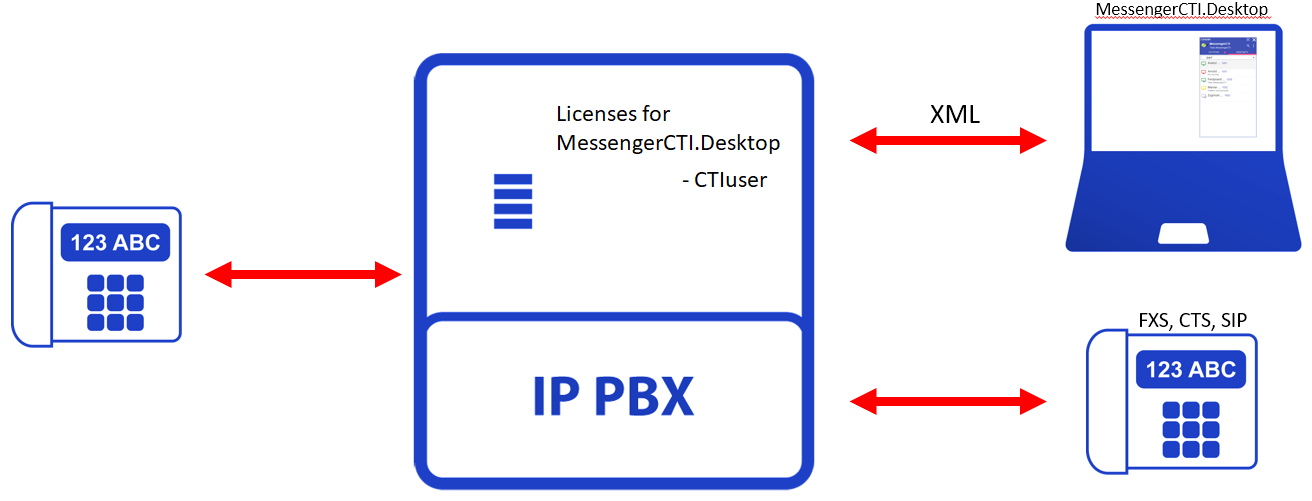
Application with VoIP mode turned ON.
Phone calls can are made with phone or with computer and application. Application allows to:
- for outgoing calls - searching for number in phone book or typing phone number using computer keyboard, initiating dialling, calling while using computer microphone and speakers or external headphones
- for incoming calls - triggering sound of incoming call, displaying calling number/name from phonebook, picking up call with computer microphone, speakers or external headphones.
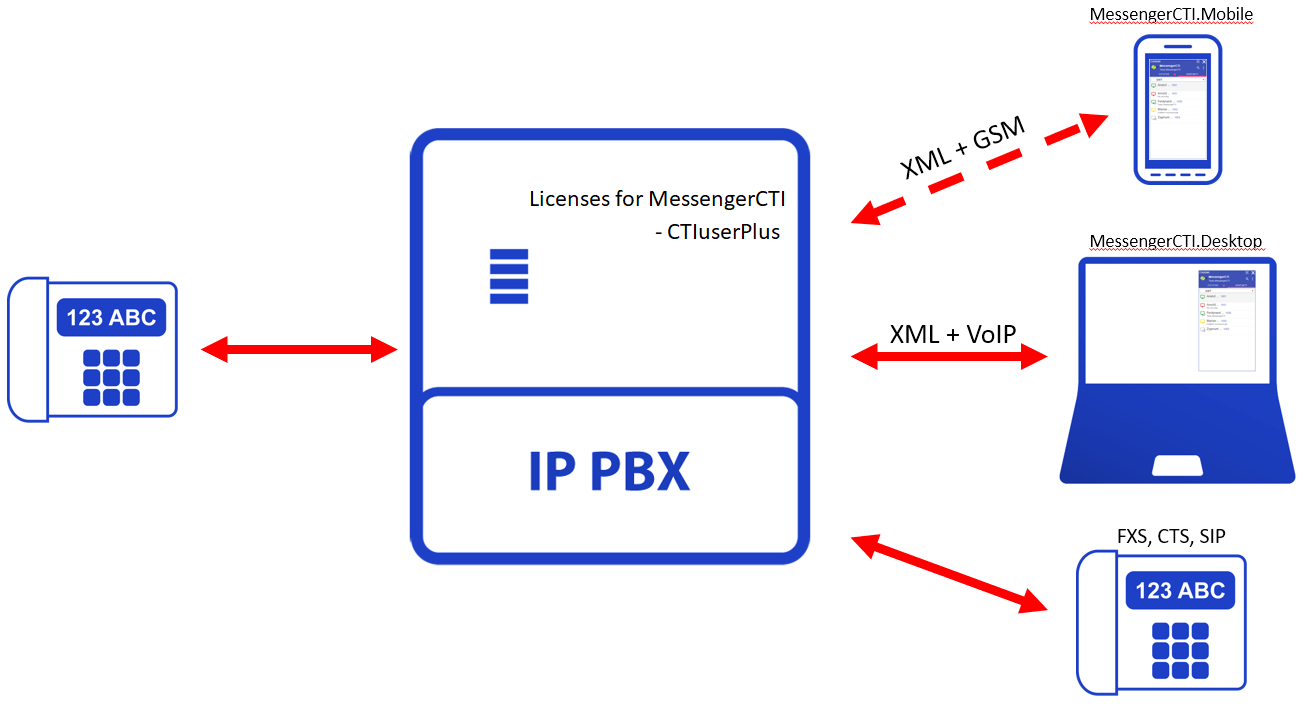
MessengerCTI.Desktop working as standalone phone (only with NCP)
Application with VoIP mode turned on.
Phone calls are made only with computer and application. Standalone applications allows:
- for outgoing calls - searching for number in phone book or typing phone number using computer keyboard, initiating dialling, calling while using computer microphone and speakers or external headphones
- for incoming calls - triggering sound of incoming call, displaying calling number/name from phonebook, picking up call with computer microphone, speakers or external headphones.
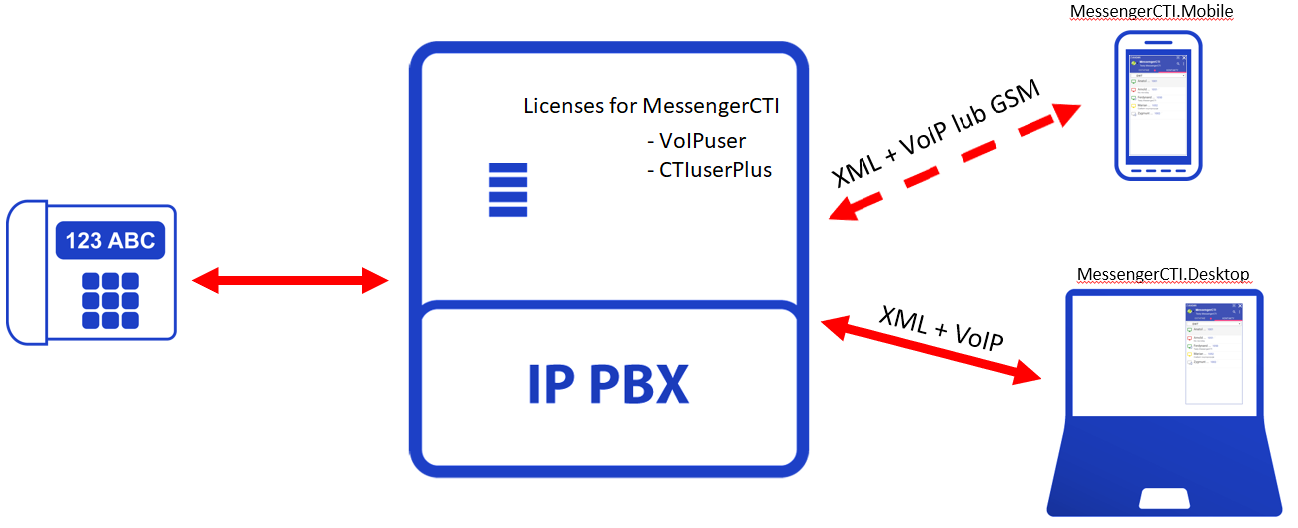
Program structure
Main window
Main windows of MessengerCTI.Desktop application contains interface which show information and allows access to chat windows and main functions.

Upper part of window:
- left side
- hyperlink to software version
- right side
- default window position button
- close - minimizing to tray button
Middle part of window:
- left side:
- changing application status button
- middle: program name,below - user status - field that can by user to provide additional urlop, for example to inform about vacation or being busy with project
- right side:
- searching (magnifying glass) - button/field for searching number or contact
- preferences - access to program settings
Lower part of window:
- access to tabs:
- contacts - phonebook from bx with sorting options
- recent - history of most recent calls and messages.
Status of application and user
MessengerCTI.Dekstop software allows to show current status of user with coloured symbol and display it inside applications of other users. Applications status is informing about user availability, depending on user actions status can be changed by him or application can change it automatically. More information can be added through text status of user. User can choose different icons/symbol to set his status manually. Additionally there is graphic informing about ringing phone or current call.
List of icons and symbols
Chart presents list of icons available in Contacts and Recent tabs:
-
 - for internal PBX users - different icon color represent current applications status. It can be set manually through main application window, by icon
- for internal PBX users - different icon color represent current applications status. It can be set manually through main application window, by icon  , also is set automatically for Be right back status.
, also is set automatically for Be right back status. -
 - for public subscribers.
- for public subscribers. -
 - for DPH.IP doorphones connected to open/closed door sensor
- for DPH.IP doorphones connected to open/closed door sensor
Chart 1: Meaning of icon status of application, users and doorphones.
Chart is showing list if icon that appear on the left side of subscriber name in tab Contacts and Recent. Internal phone will have status icon being displayed
| Phone status and camera information | |
|---|---|
| Icon | Icon meaning |
| Phone is ringing | |
| During call | |
| Camera is associeted with phone or doorphone, clicking on icon will allow to preview camera video | |
Preferences
Clicking Preferences icon in main program window will display window with program settings. In every tab there is available button with info "About software" and reseting default window position.
Connection
In Connection field you must enter settings neccesary for application to connect:

Application login setting
To login, application must have correct settings configured by PBX administrator:
- subscriber numbers - extensions from PBX
- CTI access and password:
- for IPx, MAC, CCT - ConfigMAN chart Subscribers/Settings CTI - CTI - access level and paswordPss
- for NCP - ConfigWEB chart Extensions/Subscribers/CTI setting - CTI Access and Password
- Server address - PBX network settings
CTI access level determines what options are available to application:
- CTI.user - MessengerCTI without VoIP and camera preview
- CTI.userPlus - MessengerCTI with VoIP and camera preview
These connections settings must be filled:
- Subscribers" field - extension number for which MessengerCTI.Dekstop will login.
- Password field - defined CTI password (may contain from 4 to 16 characters, excluding ";" or "~"). After first application login to PBX password change may be necessary.
- server IP address - IP address of PBX network interface. IP address of PBX network port. In case of logging outside od PBX network, IP address of edge router(port forwarding on router is necessary, 5529 TCP, 8100-8300 UDP for IPx, 10000-30000 UDP for NCP on PBX LAN interface).
After user will change his password, administrator no longer will have access to this passowrd. Application can be set to remember user password by checking field while login in, if field wasn't checked application will always ask for password during every login.
After proper configuration all of above fields, using "Connect" button will allow application to connect with PBX and synchronize phone book and other information related to that extension. "Successful login" will apear in lower part of window.
If login credentials, configuration settings aren't correct or there are issue with network connection those error messages may appear:
- Wrong login or password. Check if correct login or password was used.
- Connecting to PBX alternating with
- No connection to PBX Check IP address that was entered and check computer LAN connection.
General

This window allows to configure settings defining how program works and startup options. Available settings:
- Auto start on System startup - automatic start of application.
- Start minimized - application will run hidden in system task bar.
- Set "Be right back" state after - status icon will change automatically, informing about user being away from computer after defined time.
- Set shortcut for application window - changes application from Windows task bar to desktop and vice versa.
- Choose double click function(for contact or number):
- show call window - choice windows is displayed with options - number, phone call, opening chat/SMS window, closing current window
- call primary number - automatic number dialling
- show last events - recent call history to particular subscriber is displayed.
- Set this window position as default - allows to set up default application's window potion on screen.
Audio settings
These setting allow to set up audio notifications informing about incoming calls and messages and audio setting of computer audio devices.

- Enable VoIP on when available - allows application to work as VoIP client(VoIP phone)

Dialing and picking up calls
To set up call between two users, particular hardware, software and proper configuration must be supplied:
- Slican PBX
- computer with installed and configured MessengerCTI.Desktop software
- software logged to PBX with subscriber extension(Settings tab, Connection field)
- analog, VoIP or Slican system phone
- for video preview - DPH.IP doorphone with camera or phone associated with external camera(doesn't apply to VoIP phones with integrated camera)
Call can be dialled using computer mouse and computer screen. Call is made between subscribers through phone connected to PBX and associated with MessengerCTI.Desktop. After choosing subscriber number to call and dialling call, PBX will call extension choosing number(to inform about being ready to set up connection), after picking up handset PBX will set up calling connection.
Dialing calls to particular number
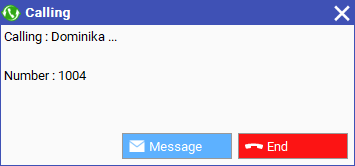
Making calls can be realised in few different way. Depending on how configured are general setting on application - option "Set double click function".
- from Contacts tab
- Search field - by directly entering phone number with computer keyboard then clicking on green phone icon.
- Recent tab - call history:
Incoming calls
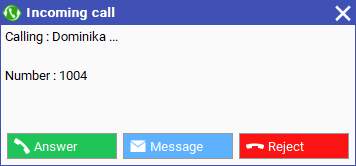
Calls are displayed on computer screen with pop-up window, ringing application and ringing phone. Depending on applied configuration call can be picked up with application or phone.
Connecting to camera video preview
Connecting to/from DPH.IP with integrated camera or associated phone or external IP camera(doesn't apply to VoIP phone with integrated cameras)will display automatically new window on computer screen. Connecting to doorphone allows to identify visible person and open door/gate with ![]() without picking up call.
without picking up call.
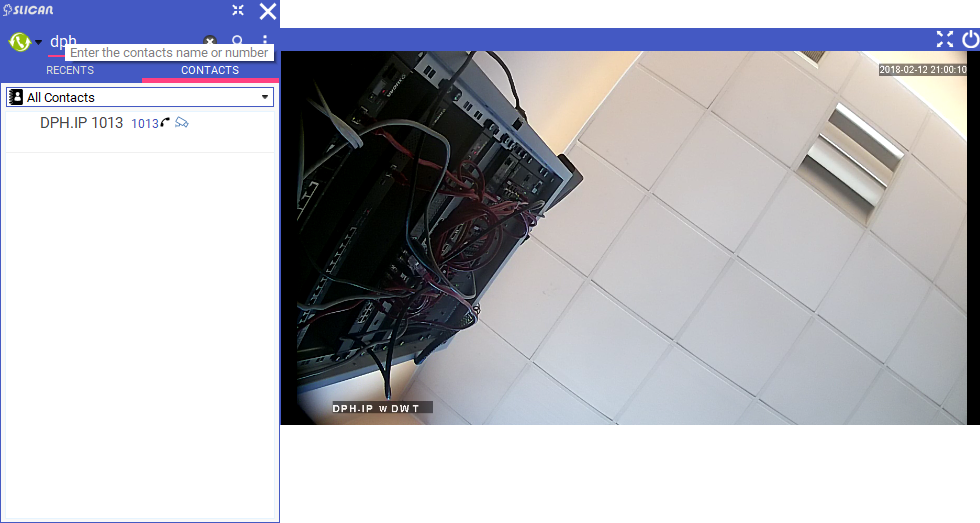
Transfering calls - version 1.03
Call can be transfered by choosing contact or number from: Recent or Contacts.
- "blind transfer" - without checking target extensions state
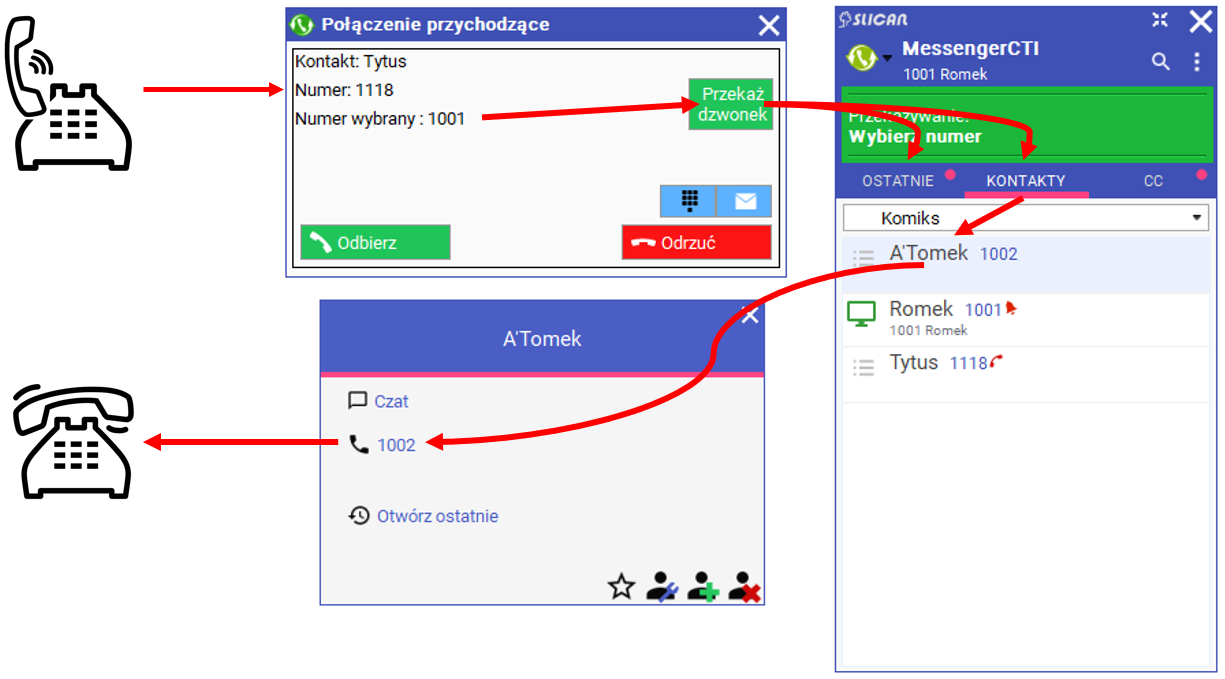
- no announcing - check target extension state without announcing
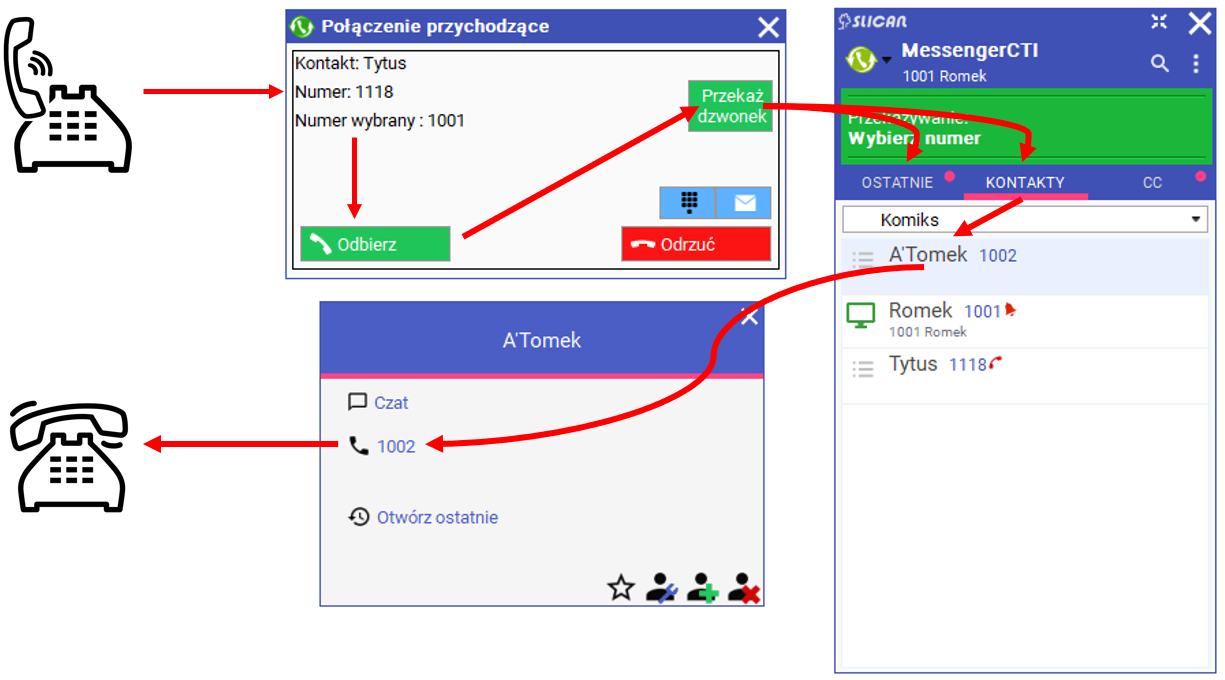
- with annoucing - check target extension state with announcing
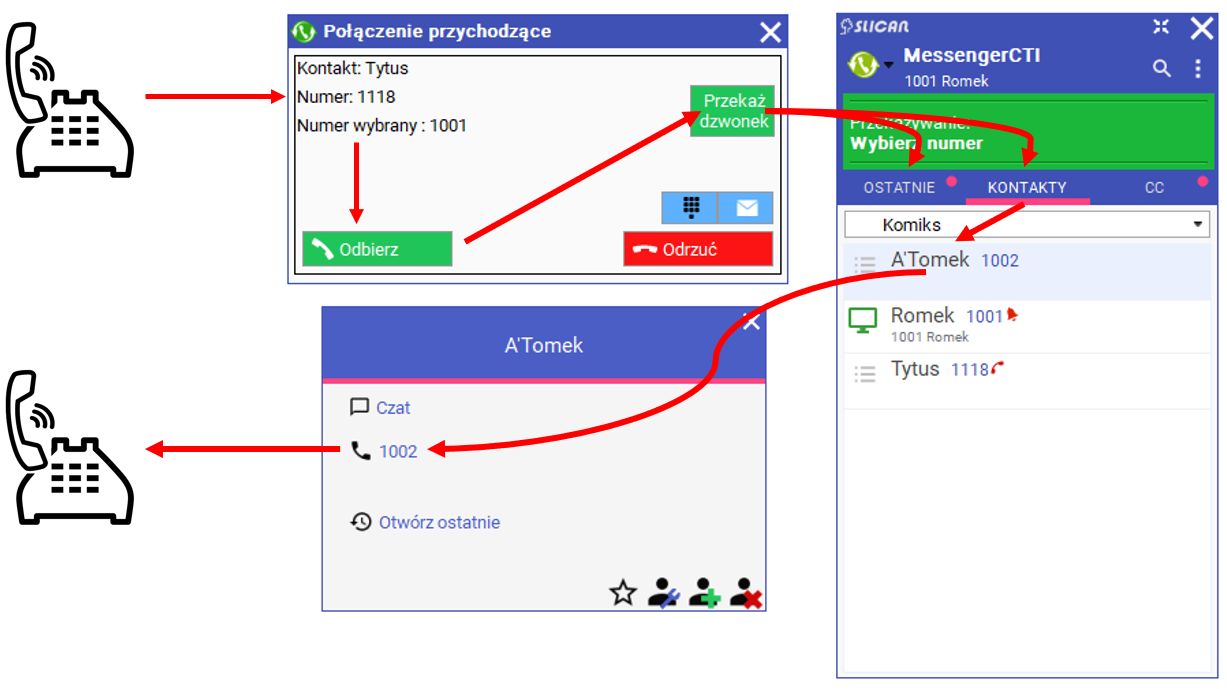
Sending messages
Application allow sending(sending and receiving) text messages between application users(internal chat) or by SMS. Message can be sent using ![]()
![]() or by typing GSM number in search field of main application window. If in PBX phone book there is GSM number associated with extension number, user sending message can choose between chat message or SMS.
or by typing GSM number in search field of main application window. If in PBX phone book there is GSM number associated with extension number, user sending message can choose between chat message or SMS.
Receving new message is signalised on Windows system task bar with two icons alternating ![]() ,
, ![]() and popping up
and popping up ![]() .
.
Messages history is available through hyper link Load previous. It is stored on computer local hard drive.
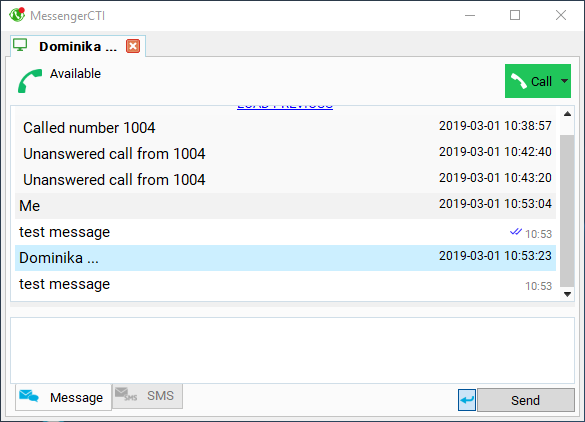
Searching data
MessengerCTI is using advanced way or text search. Searching can be accessed through Contacts tab in Search:

During entering characters/signs in search field, software automatically searches in database. Entries found in subscribers group displayed on left field side will be displayed under it. Entries from other group are classified as Suggested.
Contacts
This field allows for searching, displaying, customising and running actions related to contact. By default Favourites group is displayed. Subscribers from other groups can be accessed by extending groups list with mouse.
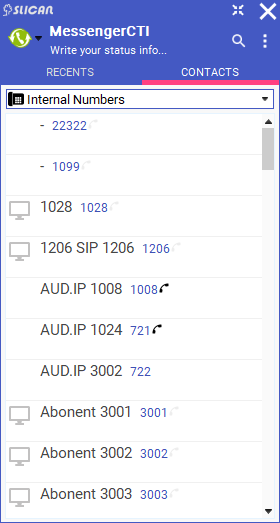
Adding contacts is possible:
- from search field - entering number and adding it with green handset icon
- from Contacts or Recent tab - right clicking on connection
From contact list we gain access to:
- favourites
- all contacts
- extensions
- created subscriber groups
- public contacts
- private contacts
Call history
Choosing Recent tab - in main program window will display call history of currently logged extension to MessengerCTI.Desktop. Window will look like this.

History is displaying all calls associated with logged in extension. Each list segment represents at least one call or message. If same subscriber(number)called/send message more then once, contact status icon will show that number. Each segment is showing caller number, his text status(for outgoing calls - chosen number and text status), length of call or call date and time. For extensions call status is also displayed. Beside text information each line have icon status for each call:
Upward arrow for outgoing call, isn't distinguished between picked up and missed call.
Downward arrow for incoming call that was picked up.
or
Turned arrow for missed incoming calls, digit is showing number of these calls.
Arrow with listed lines or text bubble for text chat or sent SMS. Digit is showing number of missed messages.
If history contains missed calls or unread messages icon in Recent field will be in colour red.
From History window call can be dialled or messages be send to chosen users by right clicking on subscribers text status
, clicking on icons ![]()
![]() and
and
. If internal subscriber have other number listed in their phone book, choice can be made between them. For internal subscribers there is option of editing, deleting contact and deleting from favourite list.
MessengerCTI.Desktop for Call Center agents
Starting from NCP 1.12 firmware and MessengerCTI.Desktop 1.02 firmware, application includes features for servicing Call Center queues. For application user which have Call Center permissions set in PBX - Windows system tool bar will have additional icon Agents status and additional tab CC in application itself.
Application state icons:
Red dot by application state informs about unanswered call or message waiting for user.
Agents state icons:
Red dot by agent state icons informs about calls unanswered by CC agents.
CC tab within application, depending on configuration is showing:
- up to 4 programmed buttons with present state for current agent: Log in/out of CC queue and Turn on/off agent pause
- serviced queues with amount of logged agents and waiting calls
- Callback list - numbers/contacts to call back
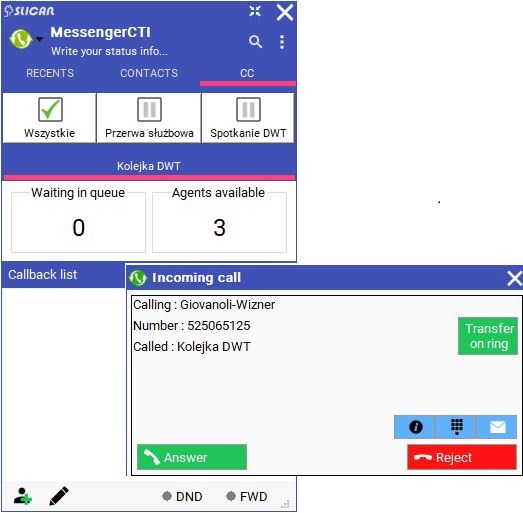
When using callback list, additional window will apear allowing to make call and field to confirm if call was successfull.
To properly configure CC tab, Call Center sections within application preferences must be set up.
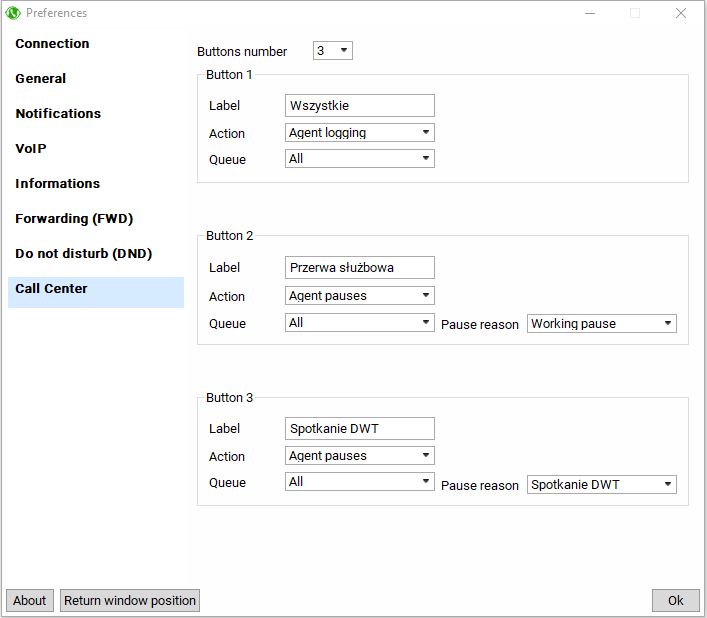
Licensing
IPX, MAC, CCT PBX
MessengerCTI.Desktop application:
- ALWAYS MUST be associated with subscriber port, analogue, system or VoIP; for subscriber ports standard licensing applies - for associating with VoIP port, 1 VoIP for subscriber license is necessary.
- for configuration using VoIP functionality(working as parallel phone) there isn't need to associate application with VoIP port, it is application functionality, it can be associated with any type of subscriber port
- calls made form application in VoIP mode are using VoIP channels just like other VoIP devices
- MessengerCTI.Dekstop configured without VoIP and camera preview access - CTIuser license is required
- MessengerCTI.Desktop configured with VoIP and camera preview access - CTIuserplus license is required
NCP PBX
MessengerCTI.Desktop:
- CAN be associated with any subscriber port - analogue, system or VoIP; each subscriber port is treated as 1 user from Base license, additionally while associating application with VoIP port 1 NCP.VoIPuser license is neccesary
- for configuration using VoIP functionality(working as parallel phone) there isn't need to associate application with VoIP port, it is application functionality, it can be associated with any type of subscriber port
- MessengerCTI.Desktop configured without VoIP and no camera preview access - NCP.CTIuser is required
- MessengerCTI.Desktop configured with VoIP and camera preview access - NCP.CTIuserPlus license is required
- MessengerCTI.Desktop as standalone subscriber - MCTI (not associated with subscriber port):
- MessengerCTI.Desktop with VoIP funcionality and camera preview access - NCP.VoIPuser and NCP.CTIuserPlus licenses are required
One user and few different numbers
Sometimes one computer use must operate with few different extensions umber. On workstation(computer) use of "instance" is neccesary. Application has to be installed (just once). User must prepare shortcuts containing extra parameters that will allow to create seperate configuration.
- default location of program instalation is: C:\Program Files (x86)\Slican\MessengerCTI\messengercti.exe
- if program can't be found in default location, Windows search option or through Start Menu. For Windows 10, open Start Menu, search for Slican directory, in directory llok for MessengerCTI, right click -> More/ Open File Location - program icon will appear, right click -> Properties/Shortcut/Target
- create program shortcut on desktop
- in shortcut properties add instance - Properties/Shortcut/Target: "C:\Program Files (x86)\Slican\MessengerCTI\messengercti.exe" -instance 1
- create as many copies of shortcut as needer for user, in each next one change instance digit for next number, for example: -instance 2, -instance 3, ...
- while running aplication from shortcuts we can configure each one seperatly for different numbers